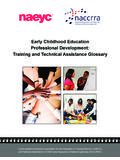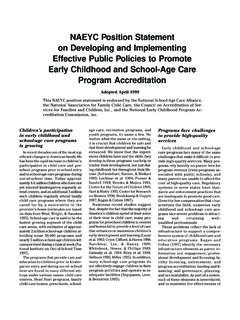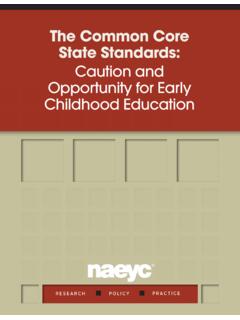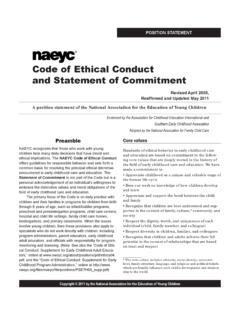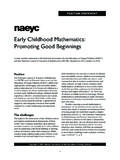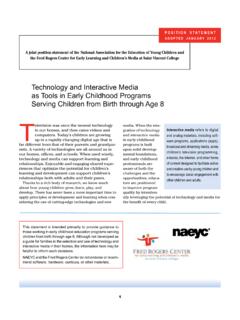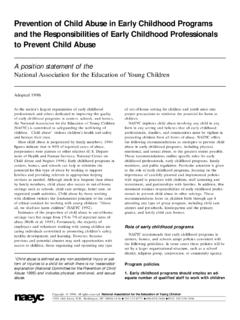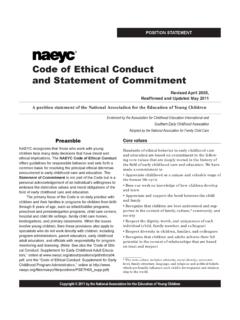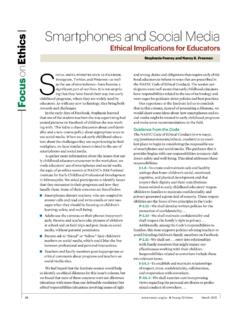Transcription of A Conceptual Framework for Early Childhood Professional ...
1 A Conceptual Framework for Early ChildhoodProfessional DevelopmentIntroductionFor more than 60 years, the National Association for theEducation of Young Children (NAEYC) has worked topromote high-quality Early Childhood programs for all youngchildren and their families. Two major strands of activitysupport this goal: (1) facilitating the Professional develop-ment of individuals working for and with young children birththrough age eight, and (2) improving public understandingand support for high-quality Early Childhood s efforts have helped to create growing recogni-tion of the importance of high-quality Early childhoodprograms to our society and an increasing demand forservices. Nonetheless, serious barriers remain that under-mine access to high-quality services for all young is increasing recognition that systemic approaches arerequired to address these barriers. A growing number ofstates and communities are employing comprehensiveplanning efforts to improve their Early Childhood care andeducation systems.
2 Although these efforts vary considerablyby state and community, there is typically recognition of thefollowing key elements (NASBE, 1991; Melaville, Blank, &Asayesh, 1993; Morgan et al., 1993; Galinsky, Shubilla,Willer, Levine, & Daniel, 1994; Kagan & the Quality 2000 Essentials Task Force, 1994):1. a holistic approach to the needs of children and theirfamilies that stresses collaborative planning and serviceintegration across traditional boundaries of child care,education, health, and social services;2. systems that promote and recognize quality throughlicensing, regulation, and accreditation;3. an effective system of Early Childhood professionaldevelopment that provides meaningful opportunities forcareer advancement to ensure a well-qualified and stableworkforce;4. equitable financing that ensures access for all children andfamilies to high-quality services; and5. active involvement of all players providers, practitioners,parents, and community leaders from both public and privatesectors in all aspects of program planning and , working in conjunction with many other groups,is addressing each of these issues.
3 NAEYC s leadership hasbeen especially important in defining quality standards forprograms for young children and for Early Childhood profes-sional preparation programs. NAEYC standards for programsfor children include its accreditation system and standards forhigh quality in Early Childhood programs, developmentallyappropriate practice, and appropriate curriculum and assess-ment. NAEYC s National Institute for Early ChildhoodProfessional development fosters the development of acomprehensive, articulated system of Professional develop-ment for all individuals working in all Early childhoodsettings, recognizing that individuals will pursue differentcareer paths and will bring different experiences, resources,and needs to the preparation believes that efforts to promote a high-qualitysystem for Early Childhood Professional development can be acatalyst to successfully address barriers to high quality for allyoung children and their families.
4 As greater consensus isgained regarding the specialized skills and knowledge neededfor effective Early Childhood practice, there will be greaterexpectations and demands for such knowledge and practice,requiring a corresponding increase in support for adequatefinancing of program resources including staff compensa-tion commensurate with qualifications and , NAEYC has developed the following concep-tual Framework that identifies key principles of an effectiveprofessional development system embedded within the largersystem of effective Early Childhood service delivery. Theframework includes several components. It begins with astatement of need that describes the current diversity of earlychildhood service providers and preparation opportunitiesand outlines the assumptions upon which this Framework isbuilt. The second component uses the analogy of a lattice to describe the Professional knowledge, performances, andA position statement of theNational Association for the Education of Young ChildrenAdopted November 1993 Copyright 1993.
5 All rights reserved. National Association for the Education of Young Children1509 16th Street, , Washington, DC 20036-1426 l 202-232-8777 l 800-424-2460 l FAX: 202-328-1846naeycCopyright 1993. All rights reserved. National Association for the Education of Young Children1509 16th Street, , Washington, DC 20036-1426 l 202-232-8777 l 800-424-2460 l FAX: 202-328-1846 Conceptual Framework for Early Childhood Professional DevelopmentA position statement of the National Association for the Education of Young Childrenpage 2 of 12dispositions connected with the Early Childhood profession sdiverse roles, levels, and settings. The third componentdescribes key elements regarding the provision of profes-sional development opportunities. The fourth and finalcomponent describes guidelines for compensation that linkincreases in Professional development and improved perfor-mance to increased Framework is intended to guide decision makingrelated Early Childhood Professional development .
6 It may beused by individuals making decisions regarding their ownprofessional development , by Early Childhood programsmaking personnel decisions and policies and designing in-service training, by institutions of higher education and othercommunity-based programs involved in the provision of earlychildhood Professional development opportunities, and bypolicymakers and others concerned with the provision ofearly Childhood services. The Framework does not attempt toimpose a prescriptive model, rather it identifies key prin-ciples and premises that apply across the diverse roles andsettings of the Early Childhood need for a unifying frameworkNAEYC defines Early Childhood education to include anypart- or full-day group program in a center, school, or homethat serves children from birth through age eight, includingchildren with special developmental and learning needs. Thisdefinition includes programs in child care center, both for-profit and nonprofit; private and public prekindergartenprograms; Head Start programs; family child care; andkindergartens, primary grades, and before- and after-schoolprograms in elementary schools.
7 These programs areoperated under a variety of auspices and rely upon differentfunding systems, different regulatory structures, and differentmechanisms to prepare and certify individuals to work withyoung children birth through age eight, as briefly describedin the following diversity of Early Childhood serviceprovidersThe diversity of services within the Early Childhood fieldreflects its roots in both social welfare and there has always been considerable overlap be-tween these two traditions, especially among professionals,public perceptions presume distinct differences. Child care has traditionally been assumed to mean providing care forchildren whose parents are unavailable to provide full-timecare because of a job or other circumstances. Child carecenters and family child care homes typically offer a full-dayschedule to correspond to parents work hours and aretypically regulated by state departments of human servicesthrough facility licensure (or registration in the case of familychild care homes).
8 Staff preparation and qualificationrequirements are sometimes included in these regulations,although they are minimal even when they exist . As a result,many individuals working in centers and family child carehomes enter the field without previous Professional prepara-tion, but they gain Professional knowledge and skills on Childhood education is also rooted in the tradition ofpart-day preschool and nursery programs, traditionallyassumed to promote children s social and educational develop-ment without consideration of parental needs for full-dayprograms. Part-day preschool programs operated within theprivate sector are subject to child care facility licensure inapproximately half of the states. In some states programsmay follow regulatory procedures for private schools. Profes-sional qualifications for staff may or may not be included inthese federally funded Head Start program has historicallyoperated primarily as a part-day preschool program withcomprehensive services, including health, nutrition, socialservices, and parent involvement.
9 Head Start programs arerequired to meet federal performance standards and may alsobe required to meet state child care licensing law requires that at least one teacher in a Head Startclassroom possess a Child development Associate (CDA)credential, its equivalent, or other Early Childhood degree asof in part by the success of Head Start, more andmore public education funds have been invested in preschoolprograms in recent years. These public schoolprekindergarten programs, now offered in the majority ofstates, are usually a part-day program. Like Head Start, theseprograms are typically targeted at children deemed at risk oflater school failure, but unlike Head Start most are notdesigned as comprehensive child and family requirements in public prekindergarten programstypically exceed child care licensing requirements for special-ized Early Childhood preparation but may or may not meetteacher licensure requirements for elementary and secondaryeducation of at least a baccalaureate degree and may notrequire a specialized Early Childhood Childhood education services also encompassservices for young school-age children attending kindergartenthrough Grade 3, and before- and after-school may be a part-day or full school-day programwith teachers certified by the state, following teacherlicensure requirements.
10 Elementary grades, also operated onCopyright 1993. All rights reserved. National Association for the Education of Young Children1509 16th Street, , Washington, DC 20036-1426 l 202-232-8777 l 800-424-2460 l FAX: 202-328-1846 Conceptual Framework for Early Childhood Professional DevelopmentA position statement of the National Association for the Education of Young Children page 3 of 12a typical school day that does not conform to most parents workday, are taught by licensed teachers. Often, state teacherlicensure (certification) requirements do not fully address thespecialized skills, knowledge, and supervised practicumexperience of work with younger children. Before- and after-school programs are increasingly needed because of thegrowing number of dual-earner or single-parent child care programs are offered by schools and avariety of private agencies, as well as in family child carehomes. Regardless of public or private sources of funding,qualifications for school-age child care personnel are moresimilar to those included in child care facility licensure thanpublic school teacher attention to serving children with disabilitieshas had considerable impact on the provision of earlychildhood services.
